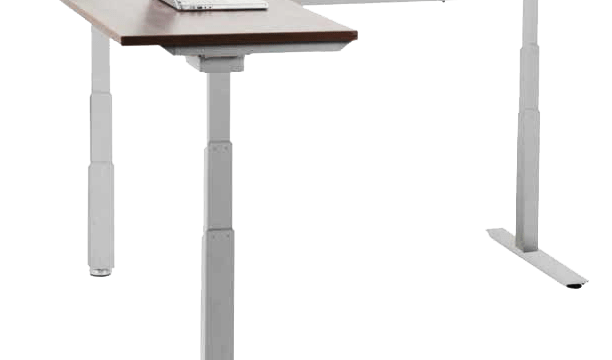If you have a sedentary lifestyle, you may find yourself sitting for long periods of time. With a busy schedule and working long hours, you can end up sitting for long periods of time during the day. Health professionals refer to the numerous problems brought on by sitting all day as “sitting disease.”
Since its launch, West Quay Offices has implemented sit-stand desks, enabling users to alternate between sitting and standing at the touch of a button or lever, thereby mitigating the negative effects of prolonged sitting. If you have a Private Office at West Quay Offices, now you have the ability to sit and stand during your workday.

Making the switch to a standing desk can be challenging if you have been seated at your desk all day for a number of years. This transition can be particularly challenging when you are on your feet. Depending on your fitness level, you may want to transition slowly into standing.
Let’s cover the transition period as well as some other things to keep in mind when you switch from sitting to standing at your desk.
Gradual Transition To A Sit-Stand Desk #
Start slow and don’t switch to standing all day right away. Start by standing for 20–30 minutes and then gradually increase the duration as your body adapts to standing more regularly.
Use a sit-stand desk to alternate between sitting and standing. Stand for a while, then sit when you get tired, and vice versa.
Desk Setup #
Keep your wrists straight and parallel to the desk surface #
The final adjustments are to ensure your wrists remain neutral: Your fingers can hang down to meet your keyboard, but your wrists should never be tilted upward or downward.
Repeated extension and flexion of the wrists (up and down) can compress their internal structure and increase their risk of developing carpal tunnel syndrome.
Monitor Position #
The top of your monitor screen should be at or just below eye level. This helps reduce neck strain. You may need a monitor mount to adjust your monitors to eye level.

If you’re working with a single-surface desk (meaning your monitor, keyboard, and computer are all on the same surface), then you may need a monitor mount to elevate your monitor(s) to your eye level.
Keep your wrists straight and parallel to the desk surface #
Your fingers can hang down to meet your keyboard, but your wrists should never be tilted upward or downward.
Repeated extension and flexion of the wrists (up and down) can compress their internal structure and increase their risk of developing carpal tunnel syndrome.
Monitor Distance #
You should position the monitor approximately an arm’s length away. You should be able to read the text on your monitor(s) without leaning forward.
According to the Occupational Safety and Health Administration (OSHA), the preferred viewing distance is between 20 and 40 inches (50 and 100 cm) from the eye to the front surface of the computer screen.
Keyboard and Mouse Position #
Both your keyboard and mouse should be at a height where your elbows are close to a 90-degree angle. Your wrists should be straight and not angled up or down.
Footwear And Floor #
Supportive Shoes #
Wear shoes with good support. Avoid heels or flat shoes without support.
Anti-Fatigue Mat #
If you’ll be standing for extended periods, consider getting an anti-fatigue mat. This can significantly reduce strain on your legs and back. Furthermore, if you want to stand without shoes, then an anti-fatigue mat is perfect for providing cushion for your feet while also allowing your feet to breathe.
Posture #
Keep your neck tall and your shoulders relaxed. Make sure to keep your knees slightly bent while standing so they’re not hyperextended or have their joints locked.
“Good posture is also known as a neutral spine. When we have good posture, the muscles surrounding the spine are balanced and support the body equally. Most back pains are attributed to sedentary habits and bad posture. Applying these recommendations will limit harm to your body.
Shift Weight #
Shift your weight between your legs periodically. Avoid locking your knees. As you begin to stand more and want to incorporate movement into your day, a great tool to help with shifting your weight and providing movement is the Standing Desk Balance Board. Check Amazon.ca to purchase.

Eyes And Lighting #
Avoid glare. #
Position your monitors to avoid glare from windows or overhead lights.
Eye Breaks #
Obey the 20-20-20 rule: every 20 minutes, look at something 20 feet away for at least 20 seconds.
Movement And Breaks #
Don’t just stand still. Walk around every hour for a few minutes.
- Schedule movement breaks into your calendar and enable notifications.
- Periodically stretch your legs, arms, and back.
- Find your perfect sitting and standing position with our adjustable-height standing desk.
You should alternate between sitting and standing. Just like sitting all day can harm your body, standing all day can as well. Alternating between sitting and standing can help prevent body pain. According to studies, the ratio of sitting versus standing time should be 1:1 or 2:1. That means that for an eight-hour workday, you should stand between 30 and 45 minutes per hour. This will keep you active and productive.
Switching between sitting and standing will keep you active and boost productivity. Indeed, studies have shown that the above-mentioned ratios of sitting versus standing are optimal for comfort and energy levels.
Environment #
Keep the area around your desk clutter-free to allow simple movement and reduce the risk of tripping or knocking items over.
To reduce bending or overreaching, keep items you frequently use, such as a phone or notepad, within easy reach.
Listen To Your Body #
Pain is a signal. If you feel pain or discomfort, it’s a sign that something isn’t right. Adjust your setup, change your posture, or take a break from standing
Remember to breathe. #
Try the practice of taking 3 deep breaths every time you move from sitting to standing. Breathe deeply and try relaxing your entire body with every exhale.
Conclusion: Transitioning To A Standing Desk #
Keep in mind that standing desks are not a panacea. The key is movement. Whether you’re sitting or standing, make sure you change your posture, take breaks, and move around regularly.
To summarize:
- Always adjust your standing desk to your elbows’ height.
- Keep your neck tall and your shoulders relaxed.
- Don’t lock your knees while standing.
- Keep your screen at eye level.
- Keep your wrists straight and parallel to the desk surface.
- Don’t stand for more than 60 consecutive minutes.
- Don’t sit for more than 30 consecutive minutes.
Canadian Centre for Occupational Health and Safety
There is a good article about office ergonomics covering topics such as why to use a sit/stand desk, how a sit/stand desk should be set up, and how long a person should sit or stand.
Here is a helpful video from the Mayo Clinic: Tips for Transitioning to a Standing Desk







